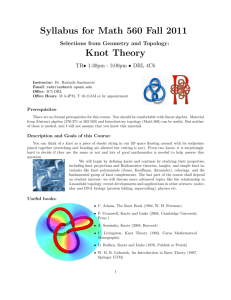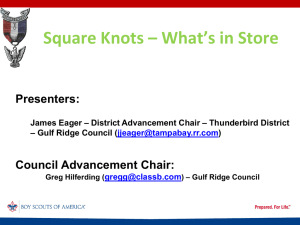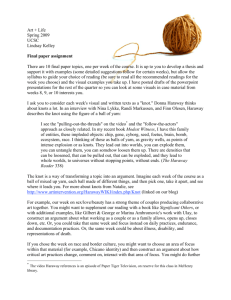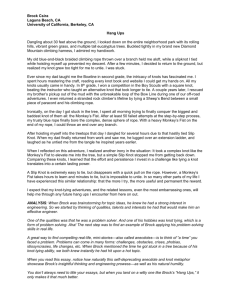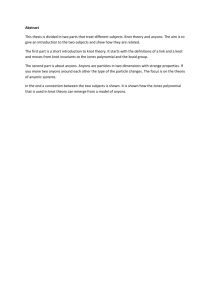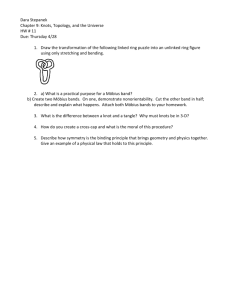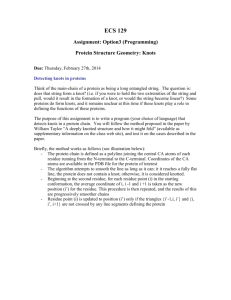Knot theory
advertisement
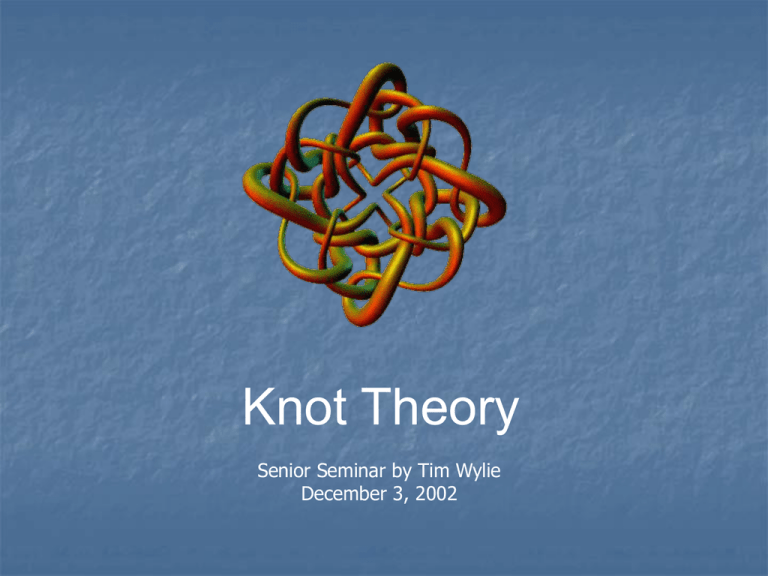
Knot Theory
Senior Seminar by Tim Wylie
December 3, 2002
Outline
•Introduction with brief history
•Lord Kelvin’s atom
•Defining a knot
•History and Progress
•Individual advances in the field
•Applications
•Conclusion
In 1867 Lord Kelvin proposed his theory of the vortex atom.
He was inspired by a paper by Helmholtz on vortices, and by a paper by
Riemann on Abelian functions.
His theory stated that atoms are vortex rings, the movement of the vortex
giving the illusion of matter.
It also stated that chemical properties of elements were related to knotting
that occurs between atoms.
Peter G. Tait
In 1877 published the first paper addressing
the enumeration of knots.
Over the next few years he began working
with C.N. Little and together they completed
all the enumerations of knots past 10
crossings by 1900.
Problems
When his work began, the formal mathematics needed to address the subject
was unavailable.
He found the distinct knots but didn’t have the math needed to prove they
were distinct.
The Tait conjectures-conjectures about knot projections that were
unable to be proven at the time.
Topology
However, work at the beginning of the 20th century placed the subject of
topology on firm mathematical ground.
Now it was possible to precisely define knots and to prove theorems about
them.
Algebraic methods introduced into the subject became especially important,
providing the means to prove distinct knots.
So, what is a knot?
A simple definition is that a knot is a continuous simple closed curve
in three-dimensional Euclidean space R3
This however, is not an entirely accurate definition because it is
extremely difficult to deal with deformations, and it allows some
infinite wild knots that are improbable.
So, we define a knot as a simple closed polygonal curve in R3.
For any two distinct points in 3-space, p and q, let [p,q] denote the
line segment joining them. For an ordered set of distinct points
(p1, p2,……, pn), the union of the segments [p1, p2], [p2,p3],….
[pn-1, pn] and [pn,p1] is called a closed polygonal curve. If each
segment intersects exactly two other segments, intersecting each only
at an endpoint, then the curve is said to be simple.
Right, so now some pictures.
Knots are “stick knots” but are usually
drawn and thought of as smooth.
Intuitively, we realize that a smooth
knot would be closely approximated
with a very large number of segments
in a polygonal curve.
This observation leads us to a useful definition of minimizing the points
in a knot.
If the ordered set (p1, p2, ….,pn) defines a knot, and no proper
ordered subset defines the same knot, the elements of the set
{pi} are called vertices of the knot.
The two simplest knots are the right and left trefoil, which are each distinct.
In 1914 Max Dehn was the first to prove that two knots
were distinct. He proved the right and left trefoils were
distinct.
Two knots are viewed as equivalent, or of the same type,
if one can be deformed into the other knot. So to
understand equivalence you have to understand deformations.
Definition: A knot J is called an elementary deformation of the knot K if one
of the two knots is determined by a sequence of points (p1, p2,…,pn) and the
other is determined by the sequence (p0, p1, p2,…,pn), where
1. p0 is a point which is not collinear with p1 and pn, and
2. The triangle spanned by (p0, p1, pn) intersects the knot determined by
(p1, p2,….,pn) only in the segment [p1, pn].
Definition: Knots K and J are called equivalent if there is a sequence of knots
K=K0, K1,…,Kn=J with each K(i+1) an elementary deformation of Ki, for i
greater than 0.
Combinatorial Methods
The techniques of knot theory based on the study of knot diagrams.
1. The Reidemeister Moves
2. Knot Colorings
3. The Alexander polynomial
A knot diagram is the projection (or shadow) of a knot from 3-space to a plane.
It can be proven that if two knots have the same projection they are equivalent
regardless of their dimensions in R3.
The Reidemeister Moves
In 1932 K. Reidemeister invented the Reidemeister moves.
Theorem: If two knots are equivalent, their diagrams are related by a sequence
of Reidemeister moves.
In theory these tools are enough to distinguish any pair of distinct knots, however,
for knots with complicated diagrams the calculations are often too lengthy to be
of use.
Knot Colorings
The method of distinguishing knots using the “colorability” of their diagrams
was invented by Ralph Fox.
A knot is called colorable if each arc can be drawn using one of three colors
in such a way that:
1. At least two of the colors are used
2. At any crossing at which two colors appear, all three appear.
Theorem: If a diagram of a knot, K, is colorable, then every diagram of K
is colorable.
The Alexander Polynomial
In 1928 James Alexander described a method of associating to each knot a
polynomial such that if one knot can be deformed into another, both will have
the same associated polynomial.
Invariant: A quantity which remains unchanged under certain classes of
transformations. Invariants are extremely useful for classifying mathematical
objects because they usually reflect intrinsic properties of the object of study.
Calculating the Alexander Polynomial…….
1.
2.
3.
4.
Pick a diagram of the knot K
Number the arcs of the diagram
Separately, number the crossings
Define an N x N matrix where N is the number of crossings (and arcs)
5. Take a crossing numbered L. If it is right-handed with arc i passing over
arcs j and k enter a (1-t) in column i of row L, enter a (-1) in column j of
that row, and enter a (t) in column k of that row.
If the crossing is left-handed, enter a (1-t) in column i of row L, enter a
(t) in column j and enter a (-1) in column k of row L.
All other entries in row L are 0.
6. Remove the last column and row of the N x N matrix.
7. Take the determinant of the (N-1) x (N-1) matrix
AND WE’RE DONE!!!
The most simple knot to determine the alexander polynomial
of is the trefoil.
Applying the first several steps we end up with this matrix.
(1-t)
-1
-1
t
(1-t)
t
-1
t
(1-t)
Deleting the bottom row and the last column gives a 2x2 matrix.
Taking the determinant gives the Alexander polynomial A(t)=t^2 –t +1
Theorem: If the Alexander polynomial for a knot is computed using two
different sets of choices for diagrams and labelings, the two polynomials will
differ by a multiple of +-t^k for some integer k.
More History
In the mid 1930’s H. Seifert demonstrated that if a knot is the boundary of a
surface in 3-space, then that surface can be used to study the knot.
This discovery laid the foundation for the use of geometric methods in knot
theory.
In 1947 H. Schubert used geometric methods to prove that there are prime
knots.
A knot is called prime if it cannot be decomposed as a connected sum of
nontrivial knots.
Any knot can be decomposed uniquely as the connected sum of prime knots.
In 1957 C. Papakyriakopoulos succeeded in proving the Dehn Lemma, which says
that if a knot were indistinguishable from the trivial knot using algebraic methods,
then the knot is in fact trivial.
F. Waldhausen proved in 1968 that two knots are equivalent if and only if certain
algebraic properties are the same.
William Thurston proved in 1978 that the complements of knots in 3-space have
a complete hyberbolic structures.
The Tait conjectures were finally proven in the late 80’s based on a completely
different polynomial invariant using the theory of operator algebras.
The invariant was discovered in 1987 by Vaughan Jones.
Applications
The first place knot theory was seriously used was
in the study and manipulation of DNA. It was
discovered in 1953 by Watson and Crick. They
also discovered that DNA can become knotted
which makes it difficult to carry out its function.
Knot theory is also used in molecular chemistry and statistical mechanics.
A recent use of knot theory is applying it to quantum computing.
The biggest contributions of knot theory have just recently developed thanks
To the work of Vaughan Jones and his invariants.
1) all 3-manifolds can be describe in terms of knots and links via an operation
called Dehn surgery;
2) there exists a set of moves, the Kirby calculus, that allow one to move
between differing Dehn surgery descriptions of the same homeomorphic
3-manifold.
Edward Witten has discovered that knots are connected to quantum field theory
through generalized 3-manifold invariants.
Distinct knots
=
?
Acknowledgements
God
My Family
My Wife, Rachel
My Teachers
My Friends
Sources
Livingston, Charles. Knot theory. Washington, DC: Mathematical
Association of America, 1993.
Johnson, Scholz, et al. History of Topology. Amsterdam: Elsevier
Science B.V., 1999.
Crowell, Richard H., and Ralph H. Fox. Introduction to Knot Theory.
New York, NY. Blaisdell Publishing Company, 1963
A Circular History of Knot Theory
http://www.math.buffalo.edu/~menasco/Knottheory.html
The Knotplot site
http://www.pims.math.ca/knotplot/
Knot Theory: An Introduction
http://www.yucc.yorku.ca/~mouse/knots/intro.html#what
Knot Theory
http://library.thinkquest.org/12295/main.html
Knot Theory Online
http://www.freelearning.com/knots/
Questions?


